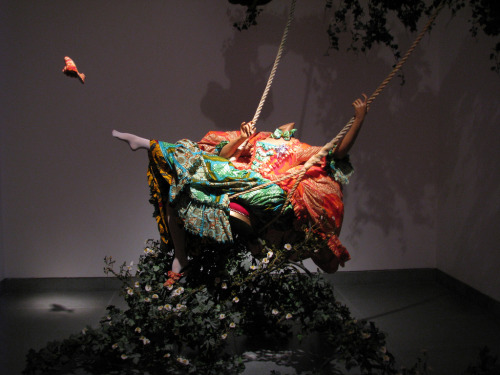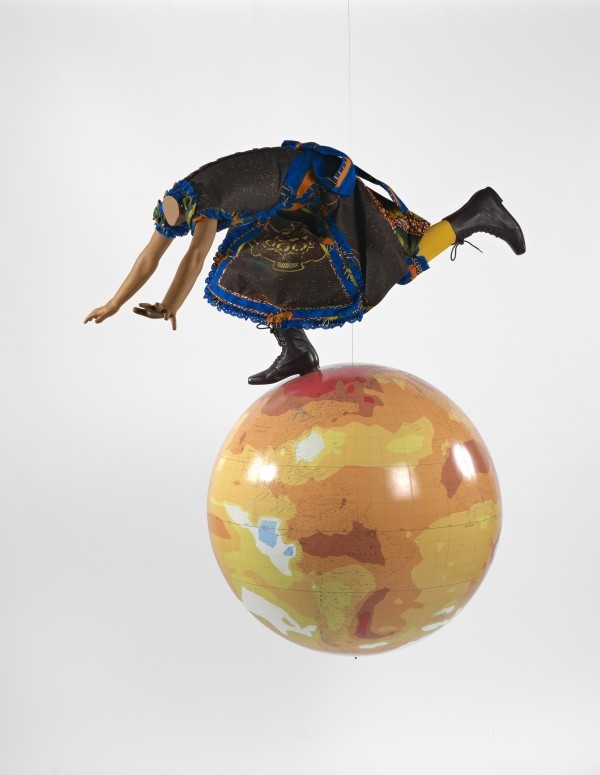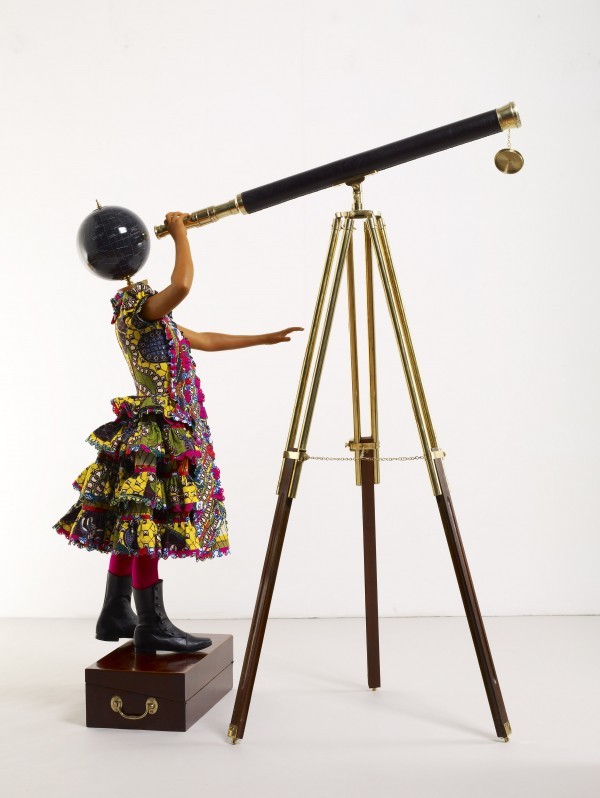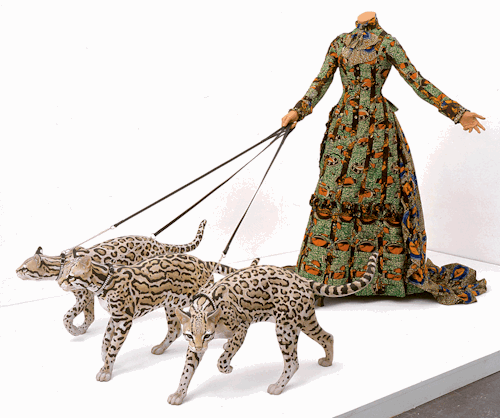Nelson's Ship in a Bottle
Yinka Shonibare, MBE
b. 1962, London
'Nelson's Ship in a Bottle' is a sculpture of Nelson's flagship 'HMS Victory'.
The sculpture considers the relationship between the birth of the British Empire, made possible in part by Nelson's victory at the Battle of Trafalgar, and multiculturalism in Britain today.
"For me it's a celebration of London's immense ethnic wealth,
giving expression to and honouring the many cultures and ethnicties that are still breathing precious wind into the sails of the United Kingdom."
Yinka Sonibare, MBE. The sculpture is 3.25 metres high and 5 metres long and weighs 4 tons
Yinka Shonibare isn't nervous about how the critics will respond to his commission for Trafalgar Square's famously empty fourth plinth.
What would be the point? The ship is in the bottle: there's no going
back now. And how, exactly, did it get into the bottle? He grins,
gleefully. "I'm not saying." Was it perhaps a hinged, fold-up vessel,
one he could unfurl inside the bottle inside using those mechanical arms
that park keepers use to pick up autumn leaves? He shakes his head. Or
maybe the bottle's neck is sufficiently wide that he was able to slither
in and out at will? "I've told you: I can't say. It's a secret." All he
will reveal is that the bottle itself is not made entirely of glass
(it's some kind of polymer blend); that it was manufactured, not in
Britain, but elsewhere in Europe; and that a wax seal on its side will
read: "YSMBE" (his initials, followed by the honour he received from the
Queen in 2005). Oh, yes, and there will be a row of Union flags along
its prow.
From the moment the Fourth Plinth Commissioning Group
wrote to him three years ago, asking him please to submit a proposal,
Shonibare knew in his gut what he wanted to stick on London's
highest-profile site for sculpture. "It's a huge honour to do something
for Trafalgar Square," he says. "And it seemed obvious to do a work that
was connected to the square in some way. I'm surprised no one has done
that before. I wanted to do a serious thing for a serious space, but I
also wanted it to be exciting, magical, and playful." His big idea was
Nelson's Ship in a Bottle,
a large-scale model of Horatio Nelson's ship, HMS Victory, from which
he commanded the Battle of Trafalgar in 1805. The twist in the tail,
however, is that this ship's sails would be made of Dutch wax, the
brightly coloured African fabric that is Shonibare's trademark.
"Nelson's victory freed up the seas for the British, and that led, in
turn, to the building of the British Empire. But in a way, his victory
also created the London we know today: an exciting, diverse,
multicultural city." So his work is intended to be celebratory rather
than critical? "Both. I want to make people think. I love London. I
don't know any city like it. It has a unique vibe. Maybe this is just a
monument to live, and let live."
Shonibare, an unexpectedly
willowy man in a spiffing powder-blue jacket, is used to attention. His
work has been shown in every major gallery in London (not to mention the
Louvre in Paris, and the Museum of Modern Art in New York), and in
2004, he was shortlisted for the Turner prize. But still, the plinth
commission is different. "The Turner was quite full-on. I'm a winner,
not a loser, and I hated not winning. It irritated me, it annoyed me.
But you move on. I was already collected, I was already making money;
the Turner didn't change anything. But then came the plinth, and that
was a huge compensation, and it already feels bigger than anything else.
The work will be there for 18 months. So many people will see it."
Where is it now? We are in Shonibare's studio in London Fields, Hackney,
the smaller of two premises in which he works, and all I can see is the
maquette he made when he submitted his original proposal. "It's
somewhere else," he says. His face is a picture of innocence, lightly
tinged with mischief.
Although he works in different media –
painting, sculpture, film and photography – Shonibare's work has
followed an unusually clear trajectory since he left Goldsmiths in 1991.
As a student, he had been busy making work about perestroika until, one
day, a tutor asked him why he didn't think about African art instead.
Intrigued by the idea that he should, as a person with a Nigerian
background, be expected to make only "African art", Shonibare began
considering stereotypes and the issue of "authenticity". His research
took him first to the Museum of Mankind and then to Brixton market. He
discovered that the exuberant batik that goes by the name of Dutch wax
was not, in fact, African; originally, it was Indonesian. Dutch
colonialists, hoping to make a profit by selling it, had set out to
manufacture the cloth commercially in the Netherlands. When their
venture failed, they palmed off the surplus on west African markets,
where it somehow became, over time, a kind of national costume for
millions of Africans: a statement, in the 20th century, of their
post-colonial independence.
Ever since, Shonibare has used the
fabric in his art, with dizzying results. Initially, he began mocking up
entire Victorian rooms, except their chaises longues were covered, not
in velvet and silk chintz, but in Dutch wax. Emboldened by the success
of these experiments, he then began using the cloth in his responses to
iconic 18th-century paintings, such as Thomas Gainsborough's
Mr and Mrs Andrews, and Henry Raeburn's
Reverend Robert Walker Skating on Duddingston Loch. In Shonibare's
Mr and Mrs Andrews Without Their Heads (1998), and in
Reverend on Ice
(2005), headless life-sized mannequins recreate the poses of the
subjects of the original paintings, only their clothes are fashioned
from Dutch wax. These installations and sculptures are provocative, of
course, but they are funny, too. "Yes,
Reverend on Ice is
funny," says Shonibare. "I wouldn't have made it otherwise. It's a
parody: it's two fingers to the establishment. I do think Raeburn's
painting is beautiful, but perhaps in a way that other people don't. I
see a dark history behind its opulence. I think: who had to be enslaved
in order for you to be able to afford a portrait painter? So it's
gallows humour, too."
His work, he believes, reflects his
ambivalent attitude towards the establishment, acknowledging the
perversity that, sometimes, a person can find something both abhorrent
and deeply attractive. In a series of photographs called
Diary of a Victorian Dandy
(1998), he presents himself as the frock-coat-wearing hero, playing
billiards, lying abed attended by half a dozen servants, or posturing
before mustachioed types in his library. "When I think of that era, I
think about domination and repression. But I also admire things about
it. I enjoyed dressing up in those clothes. I don't deny that. It's the
same with my MBE: I love it."
Is he joking? "Honestly! For one
thing, there is no British Empire. It's finished." There's still
Gibraltar, I say. He laughs. "Also, I have a whole list of
contradictions. Just because I'm a black artist, I don't want to have to
stand on a soap box all the time. I admire the Queen; I love the royal
family. A lot of people will think I don't really mean that. But I do.
The establishment is fascinating – the idea that, thanks to an accident
of birth, your whole life is laid out for you. The only thing is that I
don't know my place. I'm not at all a good subject in that sense."
Shonibare
was born in London in 1962, but moved with his family back to Lagos
when he was three. He comes from a wealthy, middle-class background: his
father was a successful lawyer; his brothers are a surgeon and a
banker, his sister is a dentist. It would be something of an
understatement to say that his parents were appalled when he started
talking about wanting to be an artist. "I was a freak! Success is so
important in Nigeria. When you're some young, tramp artist, you're
considered a drop-out. During the early part of my career, I was always
phoning home for money. My father would say: 'When are you going to grow
up?' I was on something like £5,000 a year. I wanted a deposit so I
could buy a house. I got the deposit, but, oh my goodness, the lecture!"
These days, his family's attitude is rather different. "Too bad my
father didn't live to see me get the MBE. He would have loved that –
though it's ironic that I got it by being subversive, by being the
opposite of what he wanted me to be. But [before he died] I was invited
to Windsor Castle for a party, and he was so excited. I heard him on the
phone saying: 'Yeah, I encouraged him to go to Goldsmiths.'"
After
school in Lagos, there followed a stint at a British boarding school
("a Nigerian middle-class thing; I hated it – it was cold, and all the
food was boiled, no spices") after which he enrolled at the Wimbledon
School of Art. Two weeks later, however, he fell ill; a virus in his
spine left him completely paralysed. "It took me three years to recover.
I had to learn to walk again. At first, my mum looked after me. Then I
moved to a rehab centre. It was extremely isolating. But as soon as I
was back at art school [he went to Byam Shaw and then, for his MA,
Goldsmiths, where his contemporaries included the Wilson twins and
Matthew Collings] I started winning awards. That encouraged me. I
thought: OK, I have a disability, but people can judge me by my work.
It's about what I can do. In that sense, art has been like a life
support system for me." Today, he walks with a stick, and his body is
slightly curved. But he suffers no pain. "I make sure I keep mobile, I
don't let myself get too stiff. You're only noticing because you're
meeting me for the first time."
After Goldsmith's, with its
notoriously critical tutors – "it's that military thing; they destroy
you completely and then they rebuild you" – Shonibare found himself
frozen for about two years, "unable to produce anything". In 1997,
however, his work was included in Charles Saatchi's infamous
Sensation
show at the Royal Academy. After this, there was no stopping him. "I've
been lucky. Audience response has always been good, and every time I've
done a show, it has led to invitations to do three more." What role, if
any, does he think his colour has played in his career? "I'd be lying
if I said I had suffered discrimination, though I'm not naive enough to
think it doesn't exist. But in any case, I love a challenge, so if you
don't think much of me, I will do things to make you consider me more
highly." What about positive discrimination? "People do that only once.
They invite you, and if you produce crap they won't invite you again,
full stop." On a blackboard, his schedule for the next 12 months is
already chalked up. It includes shows in Monaco and Israel, in Spain and
in Australia. He could not, he says, be busier if he tried.
I
wonder if he finds conversations about multiculturalism tiresome, for
all that his work invites them. I wouldn't blame him if he did.
Shonibare shrugs. "Culture has a role to play. In a diverse society
people have to find a way of being together, and that can only come from
understanding other cultures. Otherwise, you're just fighting for
space. But I'm from London, now. I've been here for 30 years. In Lagos, I
would feel like a foreigner. The city has had such an impact on my
work. If I'd lived somewhere else, I'm certain that my career would have
evolved very differently. And I love it. I love what you could call
'vindaloo Britishness'. It's a mixed-up thing. You hear it in British
music, and you taste it in British food. This purity notion is nonsense,
and I cherish that." His trademark Dutch wax is, he says, a metaphor
for interdependence and thus, perhaps, a metaphor for city life as well.
We all pinch from one another. We take what we like, and in doing so,
we are, whether we like it or not, joined together in one great and
vibrant web.
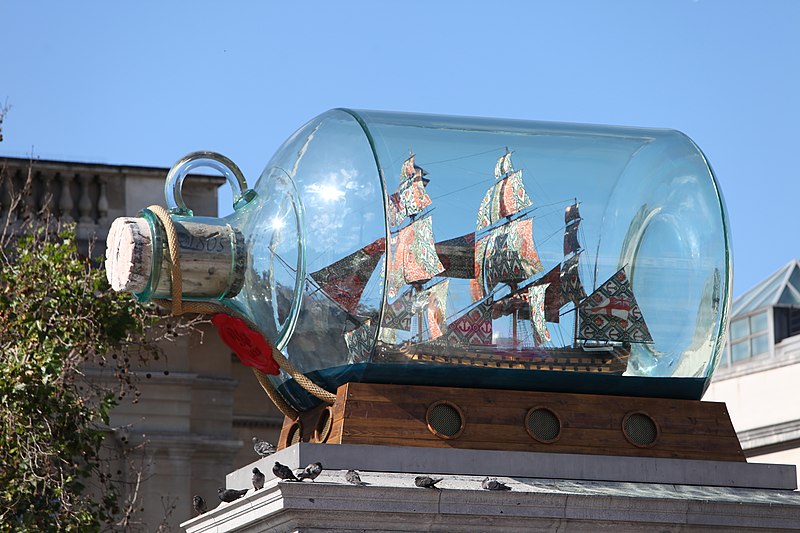
Figure 1

Figure 2

Figure 3
Work Cited: http://commons.wikimedia.org/wiki/File:Nelson%27s_Ship_in_a_Bottle_by_Yinka_Shonibare.jpg
http://www.guardian.co.uk/artanddesign/2010/may/16/yinka-shonibare-fourth-plinth-trafalgar
figure 1: http://commons.wikimedia.org/wiki/File:Nelson%27s_Ship_in_a_Bottle_by_Yinka_Shonibare.jpg
figure 2: http://adventures-of-the-blackgang.tumblr.com/post/1045056488/yinka-shonibare-victory-bottle








 Figure 1
Figure 1

